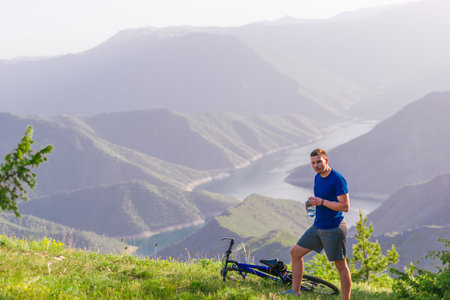1. Understanding Anxiety and Depression on the Trail
Mental health doesn’t clock out when you hit the trailhead. If you’re dealing with anxiety or depression, you know these conditions can hike right alongside you, manifesting in ways that are sometimes subtle, sometimes overwhelming. On the trail, anxiety might show up as racing thoughts about getting lost, fear of injury, or an uneasy feeling that something will go wrong at any moment. Depression may sap your motivation to keep going, make every step feel heavy, or drain your enjoyment from even the most breathtaking views. The outdoors has a unique way of amplifying both the highs and lows—while nature can offer solace and healing, it also strips away distractions and forces you to confront your mental state head-on. Out here, there’s nowhere to hide from your own mind. Understanding how anxiety and depression can play out during a hike is the first step to managing them and reclaiming the trail as a space for both challenge and recovery.
2. Prepping for a Hike: Pack Your Mind Like Your Pack
When you’re hiking with anxiety or depression, mental preparation is just as critical as choosing the right boots or packing enough water. Think of your mind as part of your gear—both need to be trail-ready. Here’s how you can get mentally set before you hit the trail.
Mental Self-Checks: Know Your Baseline
Before you step out, take a minute to check in with yourself. How are you feeling today? Is your anxiety spiking or do you feel a cloud of depression hanging over you? Recognizing where you are emotionally can help you set realistic expectations and avoid pushing yourself too far. Use the table below for a quick mental self-check guide:
| Check-In Question | Why It Matters | What To Do If Needed |
|---|---|---|
| How anxious or down am I today? | Sets your starting point; helps pace yourself. | Consider a shorter hike or easier trail if needed. |
| Did I sleep and eat well? | Poor sleep/food can worsen symptoms. | Refuel, hydrate, or rest before heading out. |
| Do I have support on this hike? | Hiking alone vs. with someone changes risk and comfort levels. | Text a friend, share your plans, or invite a buddy. |
Communication: Don’t Go Radio Silent
You wouldn’t head into bear country without letting someone know your route—and mental health deserves the same respect. Tell someone where you’re going and when to expect you back. If anxiety or depression hits hard on the trail, knowing that help is just a text away can be a lifeline. For group hikes, be upfront about what you’re dealing with—it’s not weakness, it’s smart risk management.
Gear That Supports Mental Wellbeing
Your pack isn’t just for snacks and maps. Include items that ground and calm you. Here are some examples:
| Item | Mental Health Benefit | How to Use On Trail |
|---|---|---|
| Noise-canceling earbuds or calming music playlist | Drowns out overwhelming stimuli; soothes anxiety. | Take breaks and listen when stress ramps up. |
| Pocket journal & pen | Journaling helps process thoughts and emotions. | Sit down during breaks and jot feelings or observations. |
| Favorite grounding object (stone, fidget tool) | Tactile focus calms panic or intrusive thoughts. | Squeeze or handle when anxiety spikes. |
| Emergency “comfort” snack (chocolate, trail mix) | Sugar and familiar flavors can boost mood temporarily. | Treat yourself during tough moments for a morale lift. |
Breathe In, Breathe Out: Tactical Breathing Techniques
If your mind starts racing, use tactical breathing—four seconds in, hold for four, four out, four hold. This isn’t just yoga fluff; it’s used by first responders to stay calm under pressure. Practice before your hike so it becomes second nature when stress hits mid-trail.
![]()
3. Trail Techniques: Coping Skills That Actually Work
Out on the trail, anxiety and depression can hit hard and fast—sometimes when you least expect it. But the wilderness is also a toolkit for mental resilience if you know how to use it. Here’s how to break the spiral and regain your footing when your mind starts to slip.
Grounding Yourself When Your Thoughts Spiral
When anxiety spikes mid-hike, grounding techniques are your go-to. Try the “5-4-3-2-1” method: find five things you can see (maybe pine needles, rocks, clouds), four things you can touch (tree bark, your hiking boots), three things you can hear (wind, birds, your breath), two things you can smell (earth, wildflowers), and one thing you can taste (water from your bottle). This tactical scan pulls your focus back to the present moment and away from racing thoughts.
Breathe Like You Mean It: Tactical Breathwork
Your breath is your anchor. Box breathing—a favorite among military and first responders—works wonders on the trail. Inhale for four counts, hold for four, exhale for four, hold again for four. Repeat as needed. This resets your nervous system and tells your brain you’re safe, even when everything feels overwhelming.
Nature-Based Mindfulness in Action
Mother Nature is more than a backdrop; she’s an ally in your mental health game plan. Try “noticing walks”—move slowly and deliberately, paying close attention to the colors of leaves, patterns in the dirt, or the way sunlight filters through branches. Practice mindful listening by tuning into far-off sounds first, then closer noises like your footsteps or heartbeat. These micro-meditations help short-circuit negative thought loops and reconnect you with what’s real.
Pro Survival Tip:
If things get rougher than expected, pause and set up a quick camp—even if just for a snack or water break. Give yourself permission to stop moving forward until your head clears. Mental safety is as non-negotiable as physical safety on any hike.
The Bottom Line
No matter how tough the terrain—physical or emotional—you’ve got tools to keep moving forward. Use these techniques as often as needed; there’s no shame in taking care of yourself out there. The trail isn’t just a place to walk—it’s where you learn how to fight back against anxiety and depression one step at a time.
4. Staying Safe: When Mental Health Becomes a Real Risk
Hiking with anxiety or depression is more than a mental challenge—it can turn into a real safety issue if symptoms escalate on the trail. Unlike physical injuries, mental health emergencies aren’t always visible, but they can compromise your judgment, awareness, and ability to respond to hazards. Here’s how to recognize when it’s time to shift from self-management to taking decisive action for your own safety.
Red Flags: When Symptoms Cross the Line
Everyone has off days, but certain warning signs mean you need to take your situation seriously. If you or your hiking partner experience any of these issues, consider them signals that you may be at real risk:
| Symptom/Behavior | Why It’s Dangerous on the Trail |
|---|---|
| Panic attacks (hyperventilation, chest pain, feeling of doom) | Can lead to disorientation, inability to make decisions, or getting lost |
| Disassociation or feeling “numb”/unreal | Reduced situational awareness increases risk of falls, accidents |
| Suicidal thoughts or feelings of hopelessness | Impairs judgment and decision-making; can become life-threatening in isolation |
| Severe fatigue or loss of motivation to continue | You may not have the energy or willpower to get back safely |
| Irritability leading to risky decisions (e.g., leaving the group, ignoring protocols) | Poor choices increase exposure to environmental hazards |
Decision Points: Turn Around or Call for Help?
Sometimes pushing through isn’t brave—it’s reckless. Knowing when to cut your hike short or call for backup can save your life. Here are some hard-and-fast rules:
- If you’re unable to manage basic self-care tasks (hydration, navigation), turn around.
- If your symptoms are worsening despite using coping strategies, stop and reassess.
- If you have persistent thoughts of self-harm or suicide, call 911 or use a satellite communicator immediately.
- If you become physically lost due to cognitive impairment, stay put and signal for help.
- If you feel unsafe being alone, communicate clearly with your group—don’t isolate yourself further.
The Bottom Line: Don’t Tough It Out Alone
Mental health red flags on the trail are just as real as broken bones. Recognize the danger zones and treat them with respect—your safety comes first. Use emergency resources if needed; it’s better to overreact than not react at all when it comes to your life in the wild.
5. Building Your Trail Support System
Hiking solo can be a powerful way to reflect, but when you’re managing anxiety or depression on the trail, having a solid support network isn’t just helpful—it’s essential. In the wild, your mental health is just as important as your physical safety, and building a trail support system can make all the difference between a tough trek and a transformative journey.
Trail Buddies: Your First Line of Defense
A good trail buddy is more than just someone to split snacks with—they’re your first line of accountability and encouragement. When anxiety starts to creep in or depressive thoughts try to drag you down, a friend at your side can help you stay grounded and focused. Choose hiking partners who get it—people who respect your pace, check in on how you’re feeling, and aren’t afraid to talk openly about mental health. Sometimes, just knowing you have backup is enough to keep going when things get rough.
Group Hikes: Strength in Numbers
If you’re not comfortable talking about mental health right off the bat, group hikes are a great way to ease into building connections. Outdoor clubs, local meetups, and national organizations like the American Hiking Society offer group events that bring people together from all walks of life. There’s power in numbers—shared experience fosters understanding, while group energy helps push through mental fog or fear. Remember, every hiker has faced their own mountain; you’re never truly alone out there.
Online Communities: Trail Talk Beyond the Trailhead
Don’t underestimate the value of digital support. Online forums, Facebook groups, and apps like AllTrails or Meetup connect hikers across the country who deal with similar struggles. These platforms are places to ask for advice, share wins (and wipeouts), and celebrate progress without judgment. When you’re back home processing your hike—or planning your next move—these communities can keep you motivated and remind you that setbacks are part of everyone’s story.
Whether it’s a trusted friend beside you, a crew of weekend warriors, or an online tribe cheering from afar, investing in your trail support system is non-negotiable for hikers facing anxiety or depression. On America’s trails, community isn’t just about camaraderie—it’s survival strategy. Build it strong before you need it, and let it carry you through when the going gets tough.
6. After the Trail: Processing and Planning the Next Adventure
Debrief and Reflect: Unpacking Your Trail Experience
The adventure doesn’t end when your boots leave the dirt. Once you’re back home, take time to truly process your hike. Find a quiet moment to journal about what you felt—both physically and emotionally—while on the trail. What triggered anxiety? When did you feel at peace? This honest reflection helps you identify patterns, victories, and sticking points in managing your mental health outdoors.
Post-Hike Self-Care: Repairing Body and Mind
Your body is likely sore, but don’t forget your mind needs recovery too. Prioritize hydration, balanced meals, stretching, and sleep to help your system reset. If you feel an emotional crash after the adventure—common among hikers with depression or anxiety—accept it as part of the process. Talk it out with a trusted friend or therapist if heavy feelings linger. Remember: post-hike blues are real, but temporary.
Rituals for Re-Entry
Returning to daily life can be jarring. Consider small rituals that bridge trail life and home life—a hot shower followed by meditation, unpacking gear while listening to your favorite playlist, or making a photo album from your hike. These transitions help preserve the positive effects of time spent in nature.
Using Trail Wins for Long-Term Progress
Every mile you hiked proves resilience and courage in the face of mental health challenges. Leverage these wins: write down moments when you pushed through fear or found unexpected joy. When tough days hit, revisit these notes as evidence of your strength. If you tracked symptoms before and after hiking, compare them to see how nature impacted your mood and anxiety levels.
Planning Your Next Mental Health Mission
Don’t let the momentum fade. Set a realistic goal for your next outing—even if it’s just a walk in a city park or an overnight campout nearby. Involve friends or join a local hiking group if isolation is a challenge. Use each adventure not just as an escape, but as a building block in your long-term mental health strategy. The trail doesn’t cure anxiety or depression—but every step forward teaches you new tools for survival and growth.


